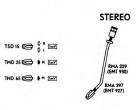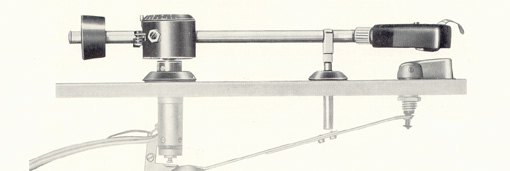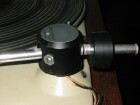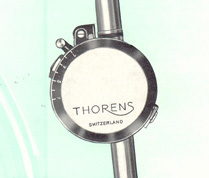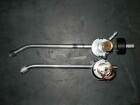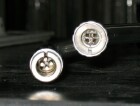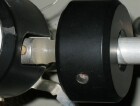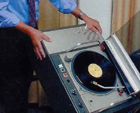|
WARNING: THE THORENS BTD-12S/TP 14 TONEARM IS NOT AN EMT!
|
|
Collecting classic audio gear is a fascinating hobby, and it’s been growing steadily in the last few years. In the beginning, there were lots of bargains to be found at eBay: the sellers were just offering for sale what they had found in attics, basements, in their grandparents’ estates and dismantled radio stations. Collectors were eager to buy those old relics; for a man like me, who never abandoned its turntables and was assembling a personal collection, it was Heaven. Thanks to the online auctions and Internet in general, many great machines of the past, neglected for years and sometimes thrown away like old junk at the arrival of digital gear, were saved from destruction and found new homes. Then the prices went up, as the audio enthusiast discovered this gold mine of superb vintage machinery, and not everything now is as convenient as it used to be, though Ebay is still a great place to buy and sell. Moreover, there has been an invasion of scammers, crooks and unscrupulous dealers/seller willing to get a quick buck on the Net with anything they can lay their hands on. The scammers often offer good gear, but their offers may hide a trap: we all know of the scams going on during the online auctions, of the many crooks trying to steal your money in any possible way, of credit card bandits, identity thieves and so on. As an old-time collector of vintage EMT and Thorens audio gear, there is a form of misrepresentation that always irritates me no end: it’s the offer through eBay or a similar structure of a Thorens TP 14 tonearm (or an even older BTD-12S!) offered not as a Thorens, but as an ‘EMT’, ‘Thorens made by EMT’ or ‘Thorens-EMT’. I’m irritated because this is a blatant lie conceived to con audio enthusiasts keen to improve their analogue setup with a high-quality EMT arm but, sadly, not informed enough to understand the differences between the Thorens and EMT tonearms. The BTD-12S and the TP 14 are NOT EMT components, were NEVER manufactured by EMT and EMT was not responsible for their design; they are both clearly labelled ‘Thorens’ and never installed on any EMT product. The REAL EMT arm is the ‘929’ (and its long brother, the ‘997’), a high-quality professional component that only looks similar to the BTD-12S/TP 14 and other vintage Thorens arms. As it’s a high-quality, very well-sounding (and very expensive) arm, collectors and audiophiles pay hundreds of dollars for a used one; so several less than honest dealers try to get an advantage selling their BTD-12S/TP 14 as ‘EMT’ components, hoping that some naïve first-timer will fall for this lie and pay top money for it. Please don’t think that I don’t like the Thorens turntables and arms. In fact, I really love both EMT and Thorens. You can see my pages about both of them in my site, www.stefanopasini.it I think that mine was one of the first sites (1999) to explain the mystique of Thorens (and EMT) turntables, and there I have posted some pictures of my collection of turntables of both Marques. I’ve visited the Lahr factory, I have written the history of Thorens, I’ve been collecting Thorens since 1975. Now I own 16 Thorens (and 8 EMTs). So I’m not discussing the excellent quality of the Thorens products, and, by the way, I love the TP 14s and I have several examples of this good arm. But they’re NOT EMTs. So, let’s speak a bit about the history of these arms to explain the difference between the two and why it is so important. A growing number of ‘newcomers’ is amazed by the beauty of analogic sound and are buying classic turntables to enjoy this pleasure. Of course, we analogue hard-liners knew all the time that vinyl sounds good and that there were formidable bargains to be found on the global market taking advantage of the rush to the CD. An old EMT 930st discarded by a Ghana or Polish radio station at 2000 dollars can sound much better than any other turntable, classic or modern, and this has been a surprise for those who didn’t know this fabled Marque. The classic EMTs were all excellent machines: therefore in the last years the price of 927s has skyrocketed, the 930s enjoyed a well-deserved Renaissance and the mighty 950 was at last appreciated also as a superbly-sounding machine. The smaller 948, 938 and the iconoclastic belt-driven 928 are also much appreciated and bought eagerly by people who can’t find, or couldn’t afford, the more expensive brothers. Spurred by this ‘revival’, the prices of everything EMT connected to vinyl soared as well, one of the pricier components being, obviously, the EMT tonearm. Until 1971, EMT turntable were fitted with Ortofon arms: RF-229 (monophonic, short), RF-297 (mono, long), RMA-229 (stereophonic, short), RMA-297 (stereo, long). All those arms were manufactured by the Danish firm to EMT specifications, with the EMT/Neumann headshell attachment instead of the ‘consumer’ SME attachment. Ortofon arms for the EMT 927 and 930
Continuing to buy these expensive arms in Denmark wasn’t probably a good deal for EMT, so during the Sixties, EMT began to feel they needed to build their own tonearm for their professional turntables. The German firm was expanding and it was quite unreasonable to buy those components from an external manufacturer when EMT was able to build anything they would design in their plants. What they needed, therefore, was a tonearm design that would satisfy Mr Wilhelm Franz’s exacting standards: it had to be a high-quality arm, well-sounding, easy to adjust and to use, sturdy. The Thorens TP 14 did fit this description; when EMT bought Thorens (1966), then owned by Paillard, Wilhelm Franz judged that this evolution of the BTD-12S, introduced just that year as a perfect partner of the then-new 124/II, could have been a suitable basis for the design of the first EMT tonearm. It is clear that its design was directly derived from the other arms developed by the Swiss firm in the Sixties, a long and distinguished family that had its first high-level member with the BTD-12S, fitted to the first TD 135 and TD 124, whilst the more modern TP 14, with its silver bearing cover, was fitted to the TD 124/II and TD 135/II. The 124 is extensively examined in Dr. Rudolf Bruil's pages, whilst you can find a very good description of the Thorens arms and the TTs where they were used (with some production data) in Steve Clarke's excellent site. Please take a close look also to the very good visual documentation in Holger Trass' site to understand the differences of those arms, all based on the same original design. Thorens BTD-12S, side view The later tonearm was a particularly interesting design, a very modern ‘J-shaped arm with ball bearings and dynamic balancing, easily identifiable by its large cylindrical bearing cover (it was black on the BTD-12S and was changed to silver for the TP 14) with a small lever on the left side to control the spring that graduates the tracking force; in the last TP 14 built a pointer connected to this lever, sliding in a groove cut in the top of the bearing housing, showed the tracking force applied to the stylus, just as it was made later in the EMT 929. The TP 14 was simple, sturdy and well-sounding: it was an excellent Swiss design, reliable and effective even if admittedly somewhat lacking in visual flair.
Detail of the BTD-12S bearing A battered TP 14 'as found' The reason why this tonearm influenced the design of the superb EMT arm is that, in 1966, EMT bought Thorens. It was a crucial moment for the Swiss firm; the failure of the previous merger with Paillard-Bolex meant that Thorens was in dire need of a new perspective both from the technical and marketing points of view, and it was late on both sides. It is possible that EMT got interested in Thorens, apart from all the previous contacts the two firms had had before, for the experience of the Swiss firm on the theme of the double-chassis domestic turntable and possibly also for the quality of their tonearms. Bearing and factory folder of the BTD-12S (please click on the image) Thorens had already conquered a fair slice of the home audio market with the simple but effective ‘150’, conceived and introduced during the ‘Paillard’ era. In 1968, Thorens-Franz AG introduced their new deck: the ‘TD 125’, a high-class belt-driven turntable with a very effective suspension and an attractive, low-slung design that won the favours of the connoisseurs all over the world, becoming a steady best-seller of the firm. When EMT bought Thorens, the project was already in its final stages of definition, and Wilhelm Franz’ engineers had little influence on it; still, the TD 125 was so good that EMT decided to build out of it a highly modified, specialised professional version aimed at the comparatively impecunious ‘low-end’ of the broadcast market. This was, in theory, an excellent idea, as the ‘125’ was, and still is, a sturdy, practical machine with a lot of capabilities and a remarkable reliability. But the EMT people insisted in modifying it to make it as similar as possible, in principle, to the larger machines, thus giving it also the quick-start capability and preamp-RIAA section of the other decks; this implied that the elegant simplicity of the ‘125’ was lost, while the design was fundamentally changed to fit some much more complicated gear. Much of this new EMT ‘928’ was in fact completely new. The main chassis had been enlarged and made much higher to include the large box of the RIAA-preamp section, the suspended chassis was stiffly-sprung and cast in only one piece for both main bearing and the support of the tonearm. The speed range was changed to 33/45/78, much more reasonably than the 16/33/45 rpm arrangement of the ‘125’. At the end, one couldn’t help wondering if it wouldn’t have been better to start this project from scratch.
A standard EMT 929 arm fitted on a 'RAI' 950
The TD 125 was fitted with the TP 25 arm (an evolution of the TP 14 arm: thanks to Joachim Bung for the correction), and the EMT engineers modified it to create their 'new' arm as thoroughly as they had modified the 125 to create the 928; thus the Thorens TP 25 was completely modified, perfected. To begin with, they made it longer (nearly 15 millimetres from the bearing to the stylus) to allow the installation of the new EMT arm also on the ‘930’ and changed the headshell connector to the Neumann/EMT standard layout of the legendary TSD 15 MC ‘Tondose’ with integral shell. We must remind that the TP 25/14 does not have a standard SME attachment, using a proprietary headshell instead.
The difference in length between the two arms
Also the connection between the main tube and the back section carrying the main counterweight was modified: whilst the TP 14 rely on two metal tubes joined with a rubber gasket (that, invariably, sags and looks always limp), the 929 uses a sturdy nylon tube with a sliding aluminum grooved sleeve. It is much better, and it never goes out of shape, even with the supplementary counterweight for the heavy mono Ortofons. The bearing was improved: don’t forget that a 929 was very expensive and the EMT people were used to fit the best parts they could find for their machines, as they worked for a ‘cost-no-object’ slice of the pro market. Even the 928, though conceived as a comparatively less expensive model, cost DM 3.582 in 1971, a very high price.
The TP 14 tonearm was manufactured by Thorens in their factory in Switzerland, not in Germany; the EMT arm was first introduced on the EMT 928 and then adapted to the 930st and the other machines of the Marque. A ‘long’ derivative of the 929, the ‘997’, was installed on the last EMT 927s produced before the arrival of the 950. When the 929 entered in production, Thorens discontinued its TP 25/TP 14 and introduced, on the TD 125 MkII (1972), the TP 16, a much different design aimed at the amateur market that had shown some reluctance to accept the ‘old look’ of the TP 25/TP 14; EMT continued to build its 929 for all its machines and as a spare as well. It is still widely appreciated and its dynamic balancing allow it a great flexibility, as it can be used in the most difficult situations (see below). Dynamic balancing
|
|
Please therefore remember:
1) The Thorens TP 14 tonearm isn’t an EMT nor an EMT design, and it was NEVER produced by EMT; it is a Thorens and is clearly labelled as such. The two Marques were NEVER associated on the official name of these tonearms or of any other product (if not on some TDs labelled ‘Thorens made by EMT’); therefore, there is no reason to link a Thorens arm to the EMT brand if not for a malicious end;
2) The design of the EMT 929 is derived from the BTD-12S/TP 14/TP 25 but it is a VERY different arm, even if they look similar. The 929 is built with better materials, is longer, newer and sounds better; thus it really deserves to be paid a substantial sum, whilst the TP 14 has only a collecting value and is worth a fraction of an EMT’s price. 3) The bearing housing of the two arms is interchangeable, but the quality of the EMT is higher and using a Thorens bearing for an EMT is not advisable lest one accepts a sonic degradation. Moreover, any BTD-12S/TP 14/TP 25 is unavoidably MUCH older than any 929 on the market today. The last of the ‘classic’ Thorens arms, the TP 25, went out of production in 1971 whilst the 929 was born in that year and has been manufactured until now; 4) Some seller claim that the TP 14 has a SME-type headshell connector: this is bullshit. You CANNOT install a SME-type or EMT-type headshell on the Thorens TP 14; on the other hand you CAN install on the 929, apart from the standard EMT Tondose, any ‘short’ cartridge (Denon 103, for example) using the ‘TSD-G’ headshell; the only way to install a SME-type connector is to find one of the rare (and expensive) ‘Sonderausführung’ 929s built for this purpose, 19 mm shorter than the standard arm and with the connector for the SME-type headshell.
IT'S CLEAR THAT YOU DON'T HAVE TO PAY EMT MONEY FOR A THORENS BTD-12S/TP 14 ARM, AS IT IS NOT AN EMT AND IT IS NOT AS GOOD AS A 929. DON’T TRUST ANY SELLER ADVISING HIS BTD-12s/TP 14/TP 25 ARM AS AN ‘EMT’ OR ‘THORENS-EMT’ ITEM!
The last prices on eBay for complete arms honestly advertised by the seller and valued as such have been around $500-700 for an EMT 929, 1000-1200 for an EMT 997, $70-80 for a TP 14 or TP 25 and around $60 for a BTD-12S. On the other hand, in October 2003 a BTD12S maliciously offered as a ‘Thorens-EMT 929’ fetched $125. The buyer, poor sod, was probably tricked in believing he was being offered a 929 for pennies. When I pointed out to the seller that he was misrepresenting the item he didn’t even answer, clearly he knew it all too well… This is the reason why I have written this short guide to the identification of the two tonearms. If you want to pay a lot of money for a TP 14 it's your choice. But now you’ve been warned! |
|
...and the Thorens TD-150 is NOT an EMT!!
There is, however, someone still thinking that the magic 'EMT' brand name can be slapped over just about anything without any remorse. The honest but, let's be frank, humble TD-150 has been labeled 'EMT' by several eBay sellers who don't know history and obviously don't care, or simply want to get cash out of the 'EMT' legend with a Thorens product. The TD 150 is NOT an EMT and it was NEVER a top-of-the line Thorens. It appeared in 1965 as a first experiment in the then scarcely explored field of suspended-chassis TTs (pioneered by AR); in 1965 the top-of-the-line Thorens was the TD-124, superseded, one year later, by its improved version, the TD-124/II. So the 150 is actually a cheap good TT with a nice character, but not on par with 124s or 125s. And it is NOT an EMT: it was built for Thorens in Lahr's EMT factory but design, materials, quality control was not up to EMT's standards (nor was the price, of course). Wilhelm Franz bought Thorens in 1966, so it is clear that the 150 is simply a good Thorens without any real EMT pedigree. It has a very good performance, as it's quiet, ruls well and you can buy a good one for 75 Euros. Paying more than that is unjustifiable, as there are 150s aplenty for sale and rarely a good example can fetch something over Euro 80... if someone is not tricked in thinking that he's being offered a bargain EMT with this one. BEWARE!!
|
|
Stefano Pasini, Bologna, 26/10/2003 |
